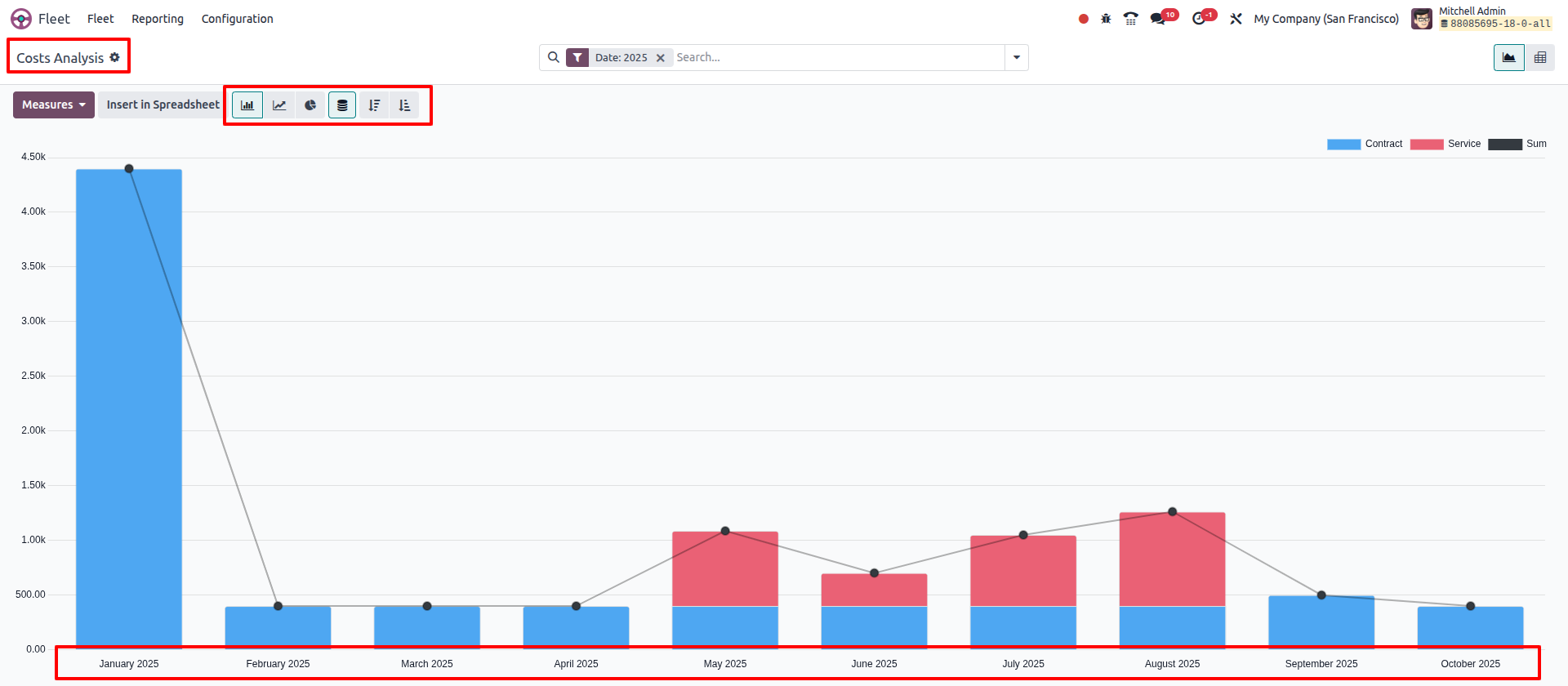Fleet Management in Odoo 18
The Fleet Management module in Odoo helps companies manage all their vehicles in one place. Whether it’s cars, trucks or bikes, you can track details like model, license plate, driver, contracts, costs and services. It reduces paperwork and makes it easy to monitor expenses such as fuel, repairs and insurance. You can also schedule regular maintenance, renew contracts on time and keep records of every vehicle. Since it is connected with Odoo’s Accounting, HR and Projects, you get a complete view of how your vehicles are being used and how much they cost. In simple words, Fleet Management makes handling company vehicles easy, cost-effective and well-organized.
Odoo Fleet Management Workflow

Key Features
- Create and manage vehicle records with details like brand, model, license plate, chassis number and tags
- Complete vehicle registration with make, model, chassis number and technical specifications
- Assign vehicles to employees or departments and change drivers when required
- Track vehicle status available, assigned, in repair,or archived
- Manage leasing, insurance and service contracts with automated renewal reminders
- Track contracts such as leasing, insurance and service agreements with start and end dates
- Digitally store documents such as contracts, registration papers and licenses
- Receive automatic alerts for contract expiry, renewals or upcoming deadlines
- Schedule preventive and corrective maintenance activities
- Log fuel consumption and fuel card usage to monitor efficiency and costs
- Log fuel consumption with per-vehicle analysis and cost tracking
- Monitor total cost of ownership (TCO) for each vehicle
- Record odometer readings automatically or manually to track vehicle usage
- Assign drivers to vehicles with shift and responsibility tracking
- Track driver licenses, expiry dates and related compliance documents
- Record vehicle expenses fuel, maintenance, tolls, fines and more
- Set up automated alerts for insurance, registration and maintenance due dates
- Generate detailed fleet reports and KPIs for usage, costs and downtime
- Manage full vehicle lifecycle from acquisition to resale or disposal
- Integration with Odoo Accounting for automatic cost allocation and journal entries
- Integration with Odoo HR for driver management and access control
- Scalable to manage fleets of all sizes with real-time data and cloud access
- Manage maintenance requests such as servicing, repairs or breakdowns
- Keep history of all costs including fuel, insurance, taxes, leasing and repairs
- Monitor recurring costs and allocate them by period (monthly, yearly, etc.)
- Link vehicle costs with the company’s accounting for accurate financial reporting
- Attach important documents like registration, insurance policy or fitness certificates
- Set vehicle status (active, reserved, in repair, sold, etc.) for better fleet visibility
- Generate reports on costs, mileage, contracts and vehicle performance
- Support for multi-company usage to handle fleets across different branches
- Smart dashboard view to quickly see total vehicles, running costs and contract alerts
- Maintain vehicle photos for identification
- Integration with Projects/Analytic Accounts for cost allocation
- Possible link with GPS/fleet tracking systems (via customization)
Fleet Master Management
- Manufacturers
- Models
- Categories
- Service Type
- Vehicle Status
- Vehicle Tags
- Activity Types
Fleet Management
- Fleet Vehicle
- Fleet Contracts
- Fleet Services
- Fleet odometer
Fleet Reporting Management
- Cost Analysis
Fleet Master Management
Manufacturers
Overview
In Odoo, Manufacturers represent the official brands or companies that produce vehicles within the fleet. Maintaining accurate and up-to-date manufacturer records is crucial for ensuring consistent vehicle classification, linking vehicle models correctly and supporting procurement and reporting processes. This data helps keep the fleet database organized and integrates seamlessly with other modules like Purchase and Maintenance.
The Manufacturers master in Odoo Fleet is used to maintain and manage information about vehicle manufacturers (OEMs). This master helps in organizing vehicles based on their make and ensures consistency across records. It acts as a reference point for vehicle registration, reporting, and analytics, making it easier to track performance, costs and reliability by brand.
Process Flow
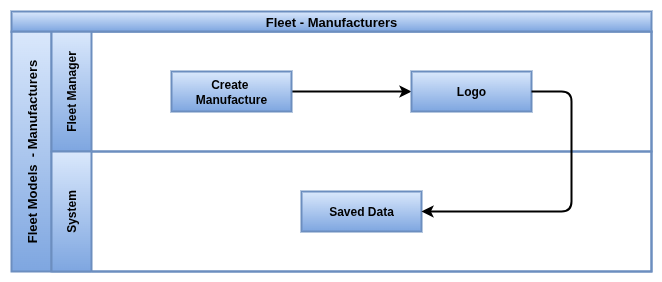
Business Rules
- Manufacturer records must uniquely identify vehicle brands or producers within the fleet system
- Each Model must be linked to exactly one Manufacturer and associated with a Vehicle Type (e.g., Bike, Car, Truck)
- Store the list of all vehicle manufacturers (e.g., Toyota, Tata, Ford, Hyundai)
- Ensure standardized naming to avoid duplicates and inconsistencies
- Assign manufacturer details to vehicles during registration
- Link vehicles to their respective brands for easy filtering and reporting
- Allow users to group and analyze fleet costs and performance by manufacturer
- Support search and filtering in the fleet dashboard using manufacturer names
- Helps in reporting recurring issues or maintenance trends specific to certain brands
Screenshot
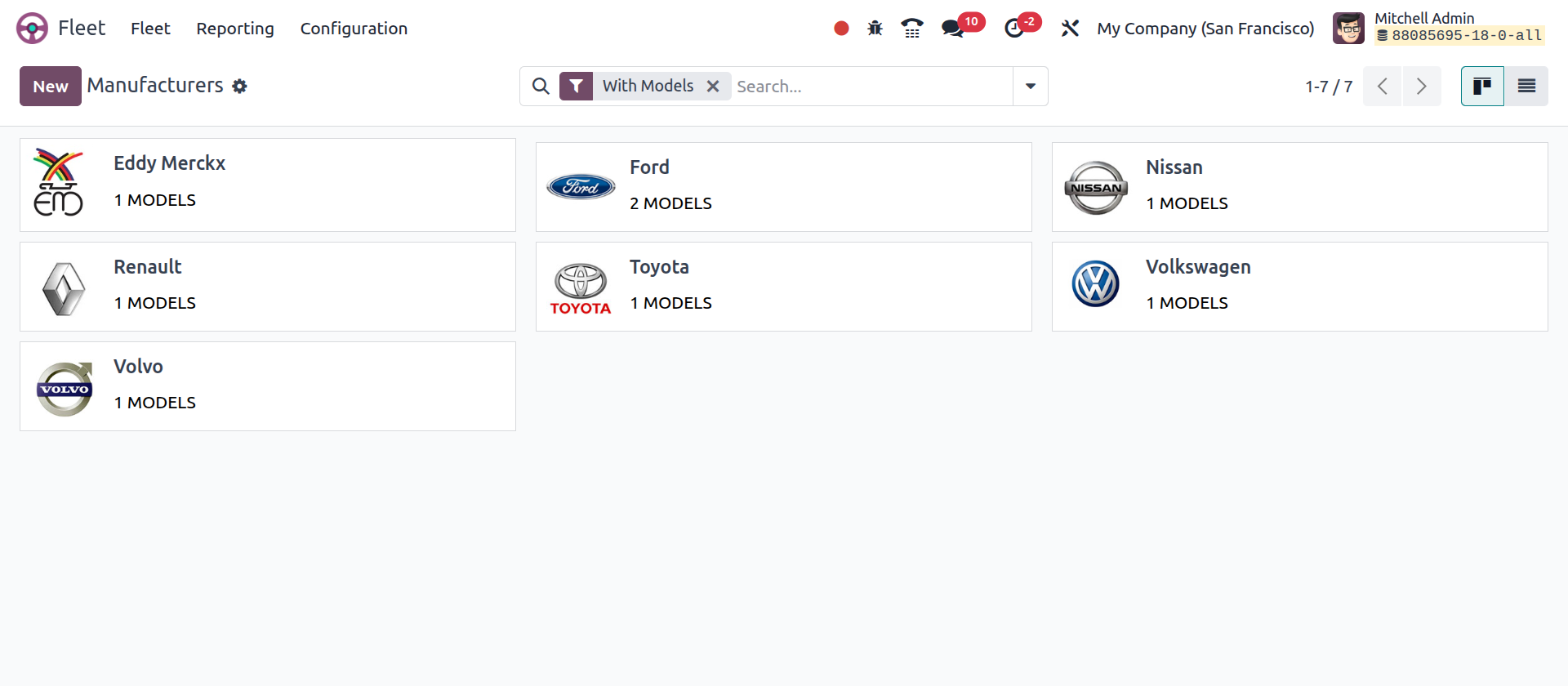
Models
Overview
In Odoo, Vehicle Models define specific vehicle configurations under a manufacturer, capturing important technical details such as seating capacity, fuel type, engine power and environmental standards. Accurate model data ensures precise vehicle classification, supports cost and emissions tracking and enables compliance with regulatory and company policies. Models are linked to manufacturers and vehicle types, facilitating streamlined vehicle registration, reporting and fleet management.
The Vehicle Models master in Odoo Fleet defines the specific models under each manufacturer. It helps classify vehicles more precisely (e.g., Toyota Innova, Tata Nexon, Ford EcoSport). Linking vehicles to their models ensures accurate reporting, cost tracking and easier maintenance planning.
Process Flow
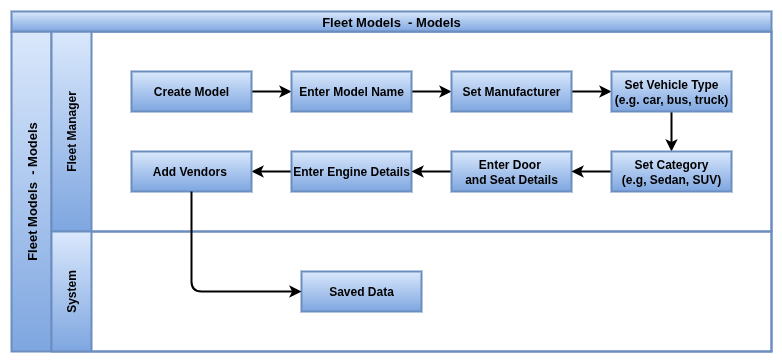
Business Rules
- Each vehicle model must be uniquely identified by its name and linked to one manufacturer
- Models are associated with a vehicle type (e.g., Car, Bike) and a category (e.g., Compact, SUV) for clear classification
- Assign models to vehicles at the time of registration
- Enable quick filtering and grouping of vehicles by model in reports
- Technical specifications such as number of seats, doors, fuel type, engine power (kW), transmission and CO2 emissions must be accurately recorded
- Environmental attributes like CO2 emissions, CO2 standard (e.g., WLTP) and range should be maintained for regulatory compliance and reporting
- Financial data including catalog value (VAT inclusive), depreciated cost, and tax deduction percentages must be tracked to support cost management and tax calculations
- Models may have optional attributes like trailer hitch availability or salary-related policies tied to vehicle benefits
- Accurate model data enables automated calculation of total cost of ownership and supports integration with accounting and HR modules
- Models should be maintained and updated by authorized personnel to ensure data accuracy and relevance
- Consistent and comprehensive model data improves vehicle assignment, driver eligibility, and fleet utilization
- Help track performance, mileage, and maintenance records by model
- Support comparison of costs and reliability between different models
- Provide a clear hierarchy: Manufacturer–> Model –> Vehicle
Screenshot

Categories
Overview
The Vehicle Categories master in Odoo Fleet allows grouping vehicles into categories for better organization, reporting and cost allocation. Categories are often linked with financial accounts and analytic accounts, making it easier to track expenses and revenues for different sets of vehicles (e.g., company cars, delivery vans, heavy trucks).
Process Flow
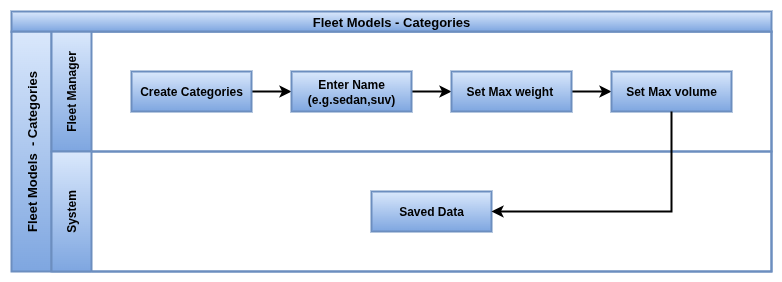
Business Rules
- Each category represents a distinct vehicle group defined by physical and operational characteristics, including parameters like maximum height and maximum volume capacity
- Vehicles or models must be assigned one category to ensure accurate classification and operational alignment
- Categories with specific parameters (e.g., max height, max volume) support logistical planning such as parking, loading and route optimization.
- Financial data linked to categories, such as average costs or allowances, support budgeting and cost control.
- Categories help apply business rules related to vehicle usage, maintenance and compliance based on vehicle specifications.
- Only authorized users can create or modify categories to ensure consistency and prevent duplication.
- Categories enhance reporting, filtering and dashboard functionalities within the fleet management system.
- Define categories such as Cars, Vans, Trucks, Buses, Motorbikes, Specialized Vehicles, etc.
- Assign a category when creating or registering a vehicle
- Enable reporting and analysis at the category level (e.g., total fuel cost for trucks)
- Support budgeting and financial planning by grouping vehicles under categories
- Provide consistency and standardization across fleet operations
Screenshot
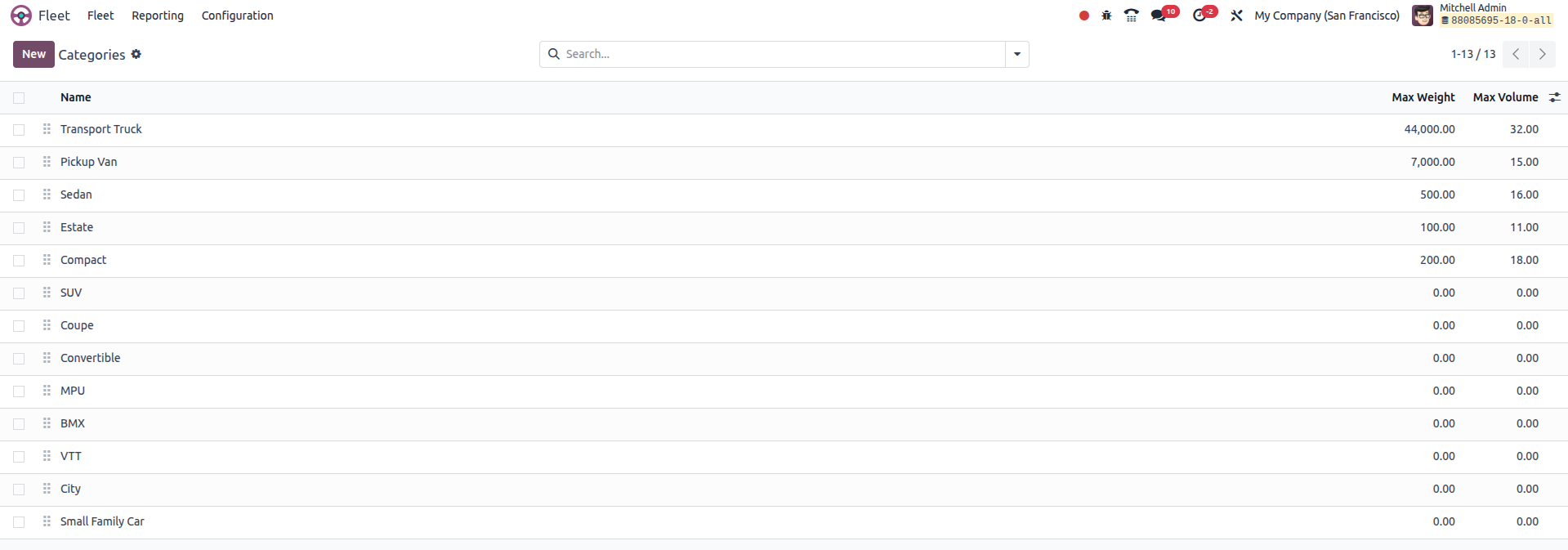
Service Types
Overview
The Service Types master in Odoo Fleet is used to define and standardize the different kinds of services or maintenance activities that can be performed on vehicles. By creating service types, companies can categorize expenses, schedule preventive actions, and analyze service costs more effectively.
Process Flow
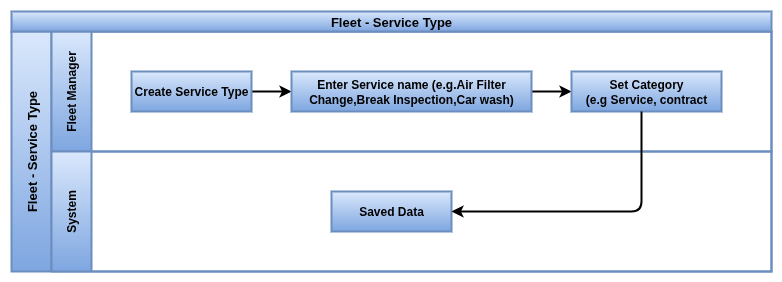
Business Rules
- Service types represent all maintenance, repair and operational activities required to keep vehicles in optimal condition
- Each fleet activity or record must be assigned a specific type to ensure accurate classification and reporting
- Types help automate scheduling, billing, and expense tracking by defining clear categories for fleet operations
- Only authorized users can create or update types to maintain consistency and prevent duplication
- Service types include a broad range of tasks such as inspections, replacements, repairs and consumables management
- Contract and service types integrate with invoicing and accounting modules for seamless financial management
- Define different types of services such as Fuel, Oil Change, Insurance, Repairs, Tires, Regular Maintenance, Cleaning, Other Custom Services
- Helps in preparing preventive maintenance schedules based on mileage, time or usage
- Ensures standardization of service entries across all vehicles
- Facilitates cost analysis (e.g., total repair costs vs fuel costs)
- Provides insights into recurring service needs and budgeting
- Improves fleet efficiency by ensuring no service type is missed
Screenshot

Vehicle Status
Overview
In Odoo, Vehicle Status tracks the current stage of each vehicle within the fleet lifecycle. Statuses such as New Request, To Order, Ordered, Registered and Reserve help monitor vehicle procurement, availability and operational readiness. Accurate status management ensures effective fleet planning, resource allocation and transparency throughout the vehicle’s lifecycle.
The Vehicle Status master in Odoo Fleet helps in tracking the real-time condition and availability of each vehicle. It ensures clarity on whether a vehicle is active, under repair or no longer in use. By maintaining accurate statuses, businesses can improve fleet utilization, avoid scheduling conflicts and plan replacements or maintenance in advance.
Process Flow

Business Rules
- Each vehicle must have a defined status to reflect its current stage in the fleet lifecycle
- Status options include stages like New Request, To Order, Ordered, Registered, Downgraded, Reserve and Waiting List
- The status transitions should follow a logical workflow, e.g., a vehicle moves from New Request → To Order → Ordered → Registered
- Vehicles marked as Downgraded indicate reduced operational capability or reassignment
- Reserve status vehicles are kept as backups and may not be in active use
- Only authorized users can update vehicle status to ensure accurate tracking
- Provides clear visibility for managers to avoid double allocation
- Helps in reporting and analysis of active vs inactive vehicles
- Ensures better fleet planning by knowing availability at any point
Screenshot
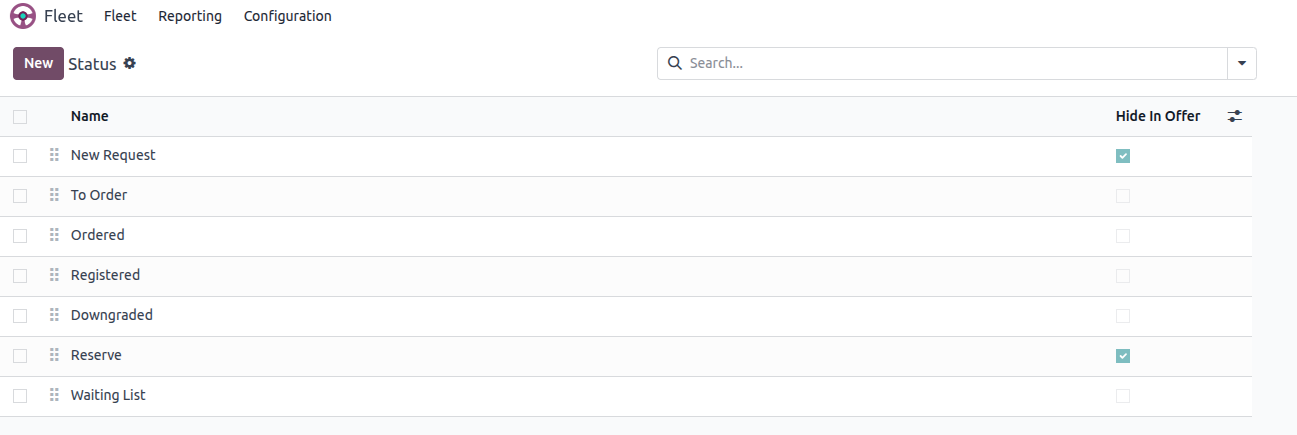
Vehicle Tags
Overview
In Odoo, Tags provide a flexible way to label and categorize vehicles with custom identifiers such as Colors, Employee Type, Ownership or Usage. Tags enhance filtering, reporting and management by allowing multiple attributes to be associated with each vehicle, enabling tailored fleet organization and operational control.
The Vehicle Tags master in Odoo Fleet allows you to classify and group vehicles based on different labels or attributes. Tags act as flexible markers that can be customised according to business needs, making it easier to search, filter and analyse vehicles within the fleet.
Process Flow
Business Rules
- Tags are customizable labels assigned to vehicles for additional classification beyond standard categories and types
- Common tags include colors, employee designation (Junior, Senior), vehicle ownership (Purchased), or usage type (Transport)
- Tags improve search, filtering and reporting capabilities within the fleet management system
- Only authorized users can create, modify, or delete tags to maintain data consistency
- Create custom tags like Electric, Diesel, Luxury, Rental, Delivery Van, etc.
- A vehicle can have multiple tags for better classification
- Tags are useful for quick searching and filtering in large fleets
- Helpful in reporting and analytics to group vehicles by tags
- Flexible and easy to maintain without changing main master data
- Enhances user experience by reducing complexity when managing hundreds of vehicles
Screenshot

Activity Types
Overview
In Odoo , define the various scheduled actions or tasks related to fleet operations, such as emails, calls, meetings, contract renewals, and document uploads. These activity types help automate reminders, streamline communication, and ensure timely completion of fleet management tasks, improving overall operational efficiency and compliance.
Process Flow
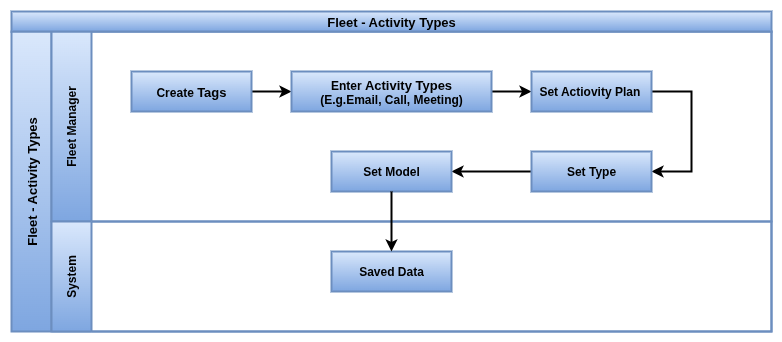
Business Rules
- Activity Types categorize recurring or one-time tasks linked to fleet management processes.
- Common activity types include Email, Call, Meeting, Contract to Renew, To-Do, Upload Document, Request Signature, and Grant Approval.
- Each activity type can have predefined settings such as default user assignment, summary, icon, and scheduling rules.
- Activities can be chained or linked to trigger subsequent actions automatically.
- Activity deadlines are often scheduled relative to the completion of previous activities (e.g., 2 days after previous deadline).
- Authorized users can create, modify, or delete activity types to tailor workflows to business needs.
Activity Type Detailed view Screenshot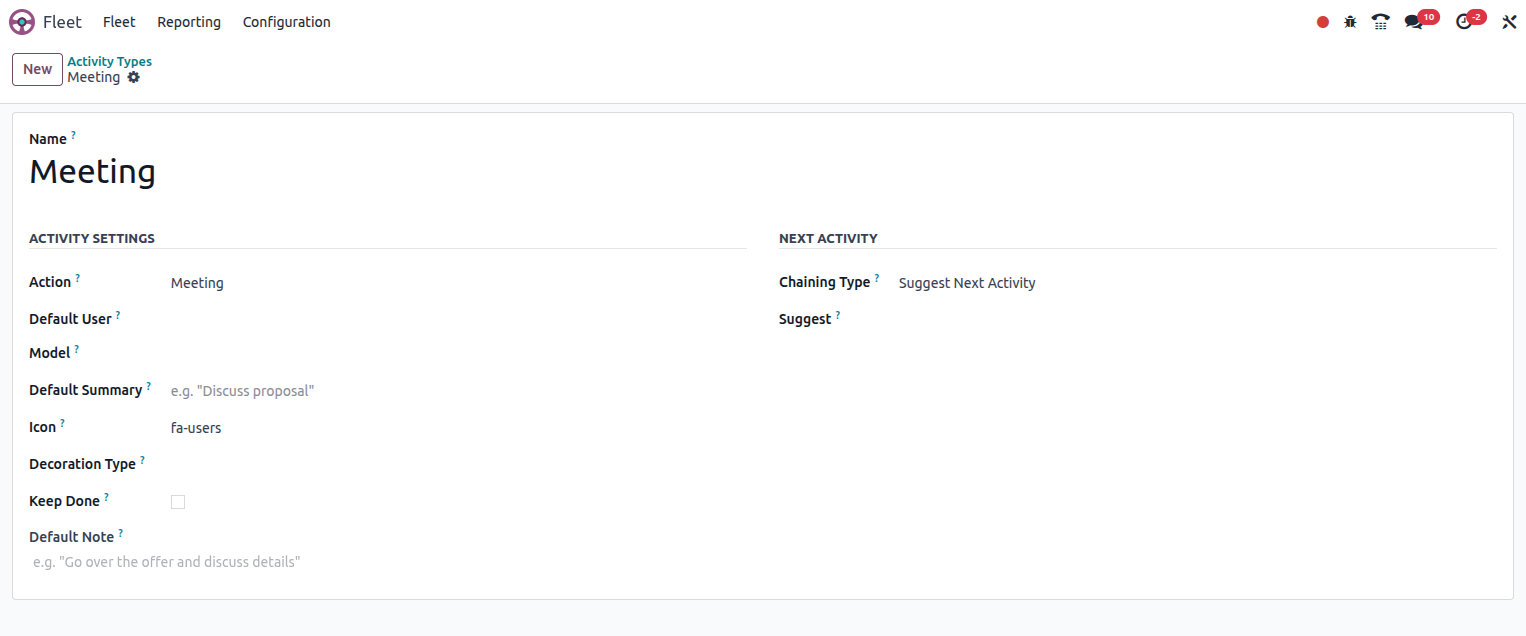
Activity Type List Screenshot
Fleet Management
Fleet Vehicles
Overview
In Odoo, Vehicles represent the actual cars, vans or any transport assets owned or managed by the company. Each vehicle is recorded with details like its model, number plate, chassis number, registration date and other specifications. The record also keeps information about ownership, driver assignment, insurance and financial aspects. By maintaining all this information in one place, companies can easily keep track of their vehicles, plan services on time, stay compliant with regulations and control costs during the complete life of the vehicle
Process Flow

Business Rules
- Each vehicle record must have a unique identifier, typically the license plate and chassis number
- Vehicles must be linked to a specific model and manufacturer to inherit technical and classification data
- Vehicle attributes such as model year, color, transmission type, engine power (kW), fuel type, seats, and doors must be accurately maintained
- Vehicles have important dates tracked including order date, registration date, assignment date, contract start date, and cancellation date for lifecycle management
- Operational data such as last odometer reading, location, fleet manager, and assigned driver are essential for day-to-day management
- Financial details including catalog value, purchase value, residual value, horsepower taxation, and disallowed expenses rate must be tracked for accounting and tax compliance
- Vehicles must have an assigned status reflecting their current lifecycle stage (e.g., New Request, Ordered, Registered, Reserve)
- Assignment of tags and optional attributes like mobility card or future driver helps customize vehicle categorization and management
- Only authorized personnel should create, update, or deactivate vehicle records to ensure data integrity
Vehicle kanban view Screenshot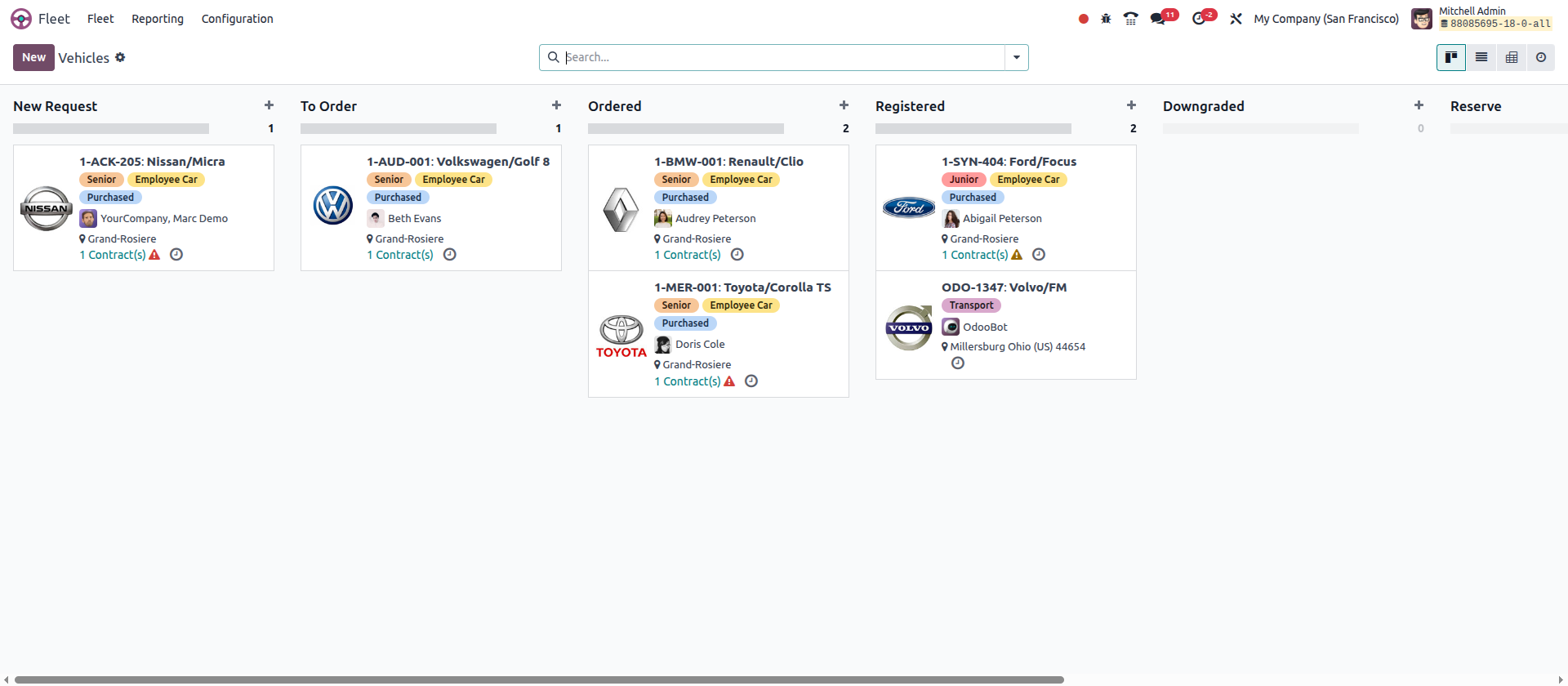
Vehicle Detailed view screenshot

Fleet Contracts
Overview
In Odoo, Fleet Contracts are used to manage all agreements related to vehicles, such as leasing, rental, insurance or service contracts. Each contract stores details like start and end dates, recurring costs, responsible person and linked vehicle. By keeping contracts well-organized in the system, companies can easily track renewal dates, avoid penalties and keep their vehicles legally and financially covered. This also helps in controlling expenses and ensuring smooth fleet operations.
Process Flow

Business Rules
- Each contract must include a reference name and be assigned a type (e.g., Leasing, Service, Insurance)
- Contracts must be linked to a vehicle, a driver and optionally a vendor responsible for service delivery or leasing
- A contract must define its start date and expiration date to calculate duration and manage lifecycle stages
- Recurring costs (daily, monthly, yearly) and optional activation costs must be specified for financial tracking
- The responsible user oversees contract execution, compliance and renewal or closure
- Contracts can include services bundled with the leasing agreement, such as maintenance, insurance or assistance
- Only authorized users can create, modify, or terminate contracts to maintain legal and operational control
- Create and manage different types of contracts like leasing, insurance, maintenance, or rental.
- Link each contract directly to a vehicle for clear traceability
- Define start date, end date, and responsible person for every contract
- Configure recurring costs (monthly, yearly or custom frequency) to track expenses
- System automatically schedules and posts recurring costs to accounting (if integrated)
- Get reminders for contract expiry or renewal to avoid penalties and downtime
- Track status of contracts such as Running, Expired or Cancelled
- Monitor financial impact of each contract with cost analysis reports
- Easily pause, renew, or terminate contracts as per requirement
- Attach digital copies of agreements, insurance papers, or related documents for reference
- Manage multi-company and multi-vehicle contracts centrally
- Integration with Fleet Vehicles ensures each vehicle has complete contract history
Screenshot

Fleet Services
Overview
In Odoo, Fleet Services are used to track all kinds of services and repairs done on vehicles, such as regular maintenance, oil changes, tyre replacements or accident repairs. Each service request is linked to a specific vehicle and can be categorized by service type, cost, responsible person and service provider. Properly managing services helps ensure vehicles remain in good condition, reduces downtime and keeps costs under control.
Process Flow
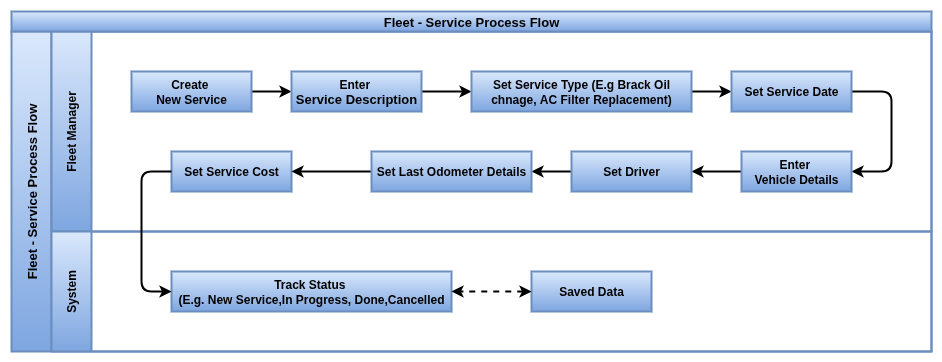
Business Rules
- Each service must be linked to a service type (e.g., Repair and Maintenance) for proper classification and reporting
- A vehicle and optionally a driver must be assigned to each service entry to ensure accurate historical tracking
- Vendors performing the service must be specified for auditing and procurement purposes
- The cost of each service must be accurately recorded for expense analysis and budgeting
- The odometer reading at the time of service must be logged to maintain a proper vehicle maintenance history
- Service descriptions and notes should clearly explain the nature of the work performed
- Only authorized users can create, edit, or close service records to maintain integrity
- Create and manage service requests for any vehicle
- Classify services by predefined Service Types (e.g., maintenance, repair, tyre change)
- Link every service request to a vehicle for full history tracking
- Record key details like service date, responsible person, vendor and notes
- Track service costs and analyze expenses across vehicles
- Attach invoices, receipts, or related documents for better traceability
- Services can be one-time or recurring, depending on need
- Set service status: New, In Progress, Done, or Cancelled.
- Schedule preventive services to avoid unexpected breakdowns
- Integration with Accounting for automatic posting of service-related costs
- Reports available for cost analysis, service frequency and vendor performance
Screenshot
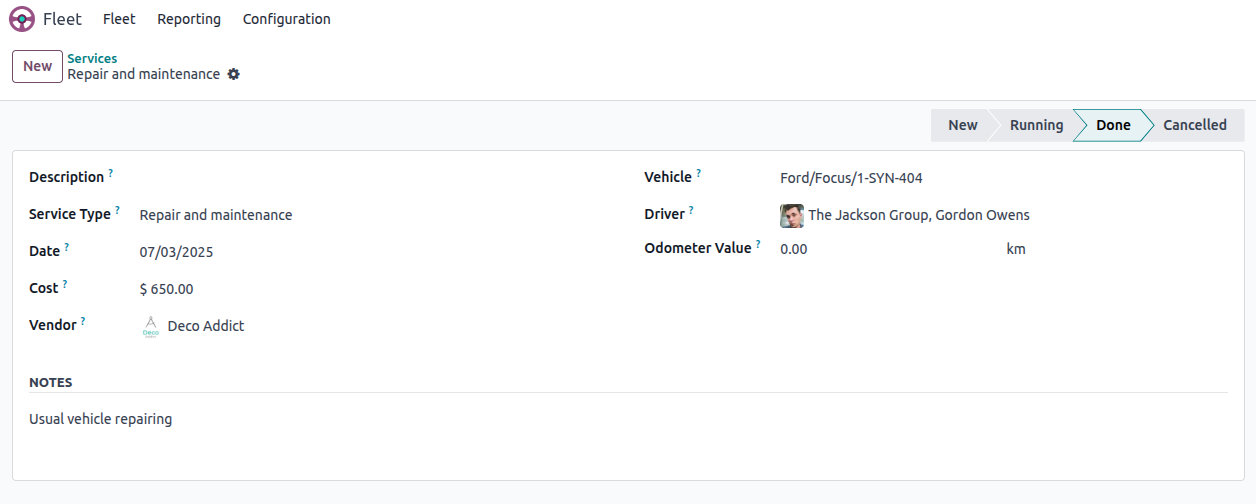
Fleet Odometer
Overview
In Odoo, the Odometer feature logs the distance traveled by individual vehicles, with each entry tied to a specific date and vehicle. These records help track usage and support maintenance and operational planning.
In Odoo, the Odometer feature is used to record and track the distance travelled by each vehicle. These readings help monitor vehicle usage, schedule maintenance (like servicing after certain kilometers) and calculate costs such as fuel efficiency and depreciation. Regular odometer updates ensure accurate records for both operational planning and financial analysis
Process Flow
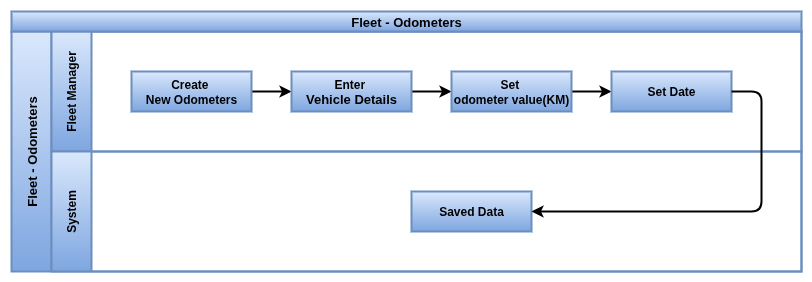
Business Rules
- Each odometer entry must be linked to a vehicle (e.g., Ford/Focus/1-SYN-404)
- The odometer value (e.g., 100 km) must be recorded accurately on the entry date
- Odometer values should increase over time to reflect actual vehicle usage
- Frequent updates (e.g., daily, weekly) help maintain accurate tracking and service planning
- The odometer data should be entered by the responsible driver or assigned user
- Historical readings (as seen in the log) help verify usage patterns and detect irregularities
- Odometer entries support analysis of vehicle activity over time
- Record odometer readings for each vehicle with date and responsible person
- Automatically link readings to the selected vehicle for history tracking
- Helps schedule preventive maintenance (e.g., service after every 10,000 km)
- Compare fuel consumption and running costs against distance travelled
- Supports multiple odometer entries per vehicle over time
- Can be updated manually by drivers, fleet managers or automated if integrated with GPS/IoT devices
- Useful for calculating vehicle depreciation and lifecycle cost analysis
- Provides reports on distance trends, over-usage or under-utilization of vehicles
Screenshot

Reporting Management
Cost Analysis
Overview
In Odoo, the Cost Analysis tool under the Reporting section provides a dynamic view of all vehicle-related costs. With built-in filtering, grouping, chart views and spreadsheet integration, it allows fleet managers to analyze service and contract expenses across vehicles and drivers for a selected time frame (e.g., year 2025).
In Odoo Fleet, the Cost Analysis Report gives a clear picture of how much each vehicle, service or contract is costing the company. It brings together expenses like fuel, services, repairs, insurance, and contracts into one view. With this, fleet managers can identify which vehicles are profitable, which ones are expensive to maintain and take informed decisions such as replacing, reallocating, or renegotiating contracts
Business Rules
- The report displays cost entries from both Service and Contract modules.
- Users can filter data by Service, Contract, Date, and custom parameters.
- Grouping can be applied by Vehicle, Driver, or other fields for cost distribution insights.
- The Comparison feature enables cost evaluation against Previous Period or Previous Year for trend tracking.
- Users can switch between list, graph, and pivot (spreadsheet) views
- Graph View supports bar, line, and pie charts for visual cost analysis.
- Pivot Table (Spreadsheet) View allows slicing and summarizing cost data with totals, averages, and custom measures.
- The spreadsheet view supports drag-and-drop fields, subtotaling, and Excel-style calculations for deeper analysis.
- Data can be exported to Excel or PDF for offline reporting or sharing.
- Saved reports or filtered views can be reused through the Favorites feature.
- Visibility and access to reporting features depend on user roles and permissions.
Screenshot